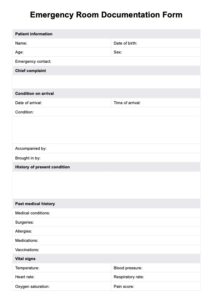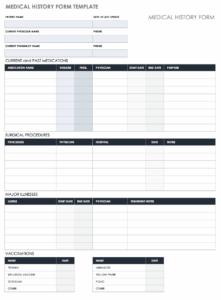Accidents happen. It’s an unfortunate truth, but being prepared to respond effectively can make all the difference. And while quick thinking and practical skills are essential during a first aid emergency, accurately documenting the incident afterward is equally vital. Why? Because proper documentation provides a clear record of what happened, the treatment administered, and the individual’s condition, which can be crucial for legal, insurance, or follow-up medical purposes. Think of it as creating a detailed narrative of the event, capturing all the important details that might otherwise be forgotten.
Choosing the right first aid documentation template can seem daunting at first, but it’s simpler than you might think. You don’t need to be a medical professional or a legal expert to create a useful and effective record. The key is to find a template that’s comprehensive, easy to understand, and customizable to fit your specific needs. There are various options available, from simple paper forms to sophisticated digital solutions, so you can select one that aligns with your resources and preferences.
In this article, we’ll explore the importance of first aid documentation, guide you through the essential elements of a comprehensive template, and highlight the benefits of using a standardized system. Whether you’re a workplace safety officer, a sports coach, a teacher, or simply a concerned citizen, having a reliable first aid documentation template on hand will empower you to handle emergencies with confidence and ensure that every incident is properly recorded.
Why is a First Aid Documentation Template So Important?
Think about it: in the immediate aftermath of an injury, adrenaline is pumping, emotions are running high, and details can easily become blurred. A first aid documentation template provides a structured way to capture critical information while it’s still fresh in your mind. This ensures accuracy and completeness, which is crucial for several reasons. For instance, if the injured person requires further medical attention, the documentation can provide healthcare professionals with a valuable overview of the initial assessment and treatment, allowing them to make more informed decisions.
Beyond immediate medical needs, proper documentation also plays a crucial role in legal and insurance matters. If an incident leads to a legal claim, a detailed first aid record can serve as evidence of the care that was provided. It can also help protect the first aider from liability, demonstrating that they acted responsibly and within the scope of their training. Similarly, insurance companies often require documentation of injuries and treatments as part of the claims process.
Moreover, a good first aid documentation template can help identify patterns and trends in workplace or organizational safety. By analyzing the data collected from multiple incidents, you can identify potential hazards, implement preventive measures, and improve safety protocols to reduce the risk of future injuries. This proactive approach can not only protect individuals but also save time and money in the long run.
Consider the implications of *not* having a reliable documentation system. Without a structured template, important details may be overlooked or forgotten, leading to incomplete or inaccurate records. This can have serious consequences, potentially jeopardizing the injured person’s care, exposing the first aider to legal risks, and hindering efforts to improve safety. Using a first aid documentation template mitigates this risk.
Finally, standardized documentation allows for consistent reporting across different individuals and settings. This ensures that everyone is using the same criteria and terminology, making it easier to compare data, track progress, and communicate effectively. A well-designed template also serves as a helpful reminder of the key steps to take during a first aid emergency, reinforcing best practices and promoting a culture of safety.
Essential Elements of a Comprehensive Template
So, what exactly should be included in a comprehensive first aid documentation template? At a minimum, it should capture the following key information: the date, time, and location of the incident; the injured person’s name, age, and contact details; a detailed description of the incident, including how it occurred and any contributing factors; a record of the injuries sustained, including their nature and severity; and a list of the first aid treatments administered, including the specific actions taken and any medications given.
In addition to these basics, the template should also include space for documenting the injured person’s vital signs, such as pulse, breathing rate, and level of consciousness. This information can provide valuable insights into their condition and help healthcare professionals assess the severity of the injury. It’s also important to note any allergies or medical conditions that the injured person may have, as this could affect the treatment they receive.
Furthermore, the template should include a section for documenting any observations made during the incident, such as the presence of hazards or environmental factors that may have contributed to the injury. This information can be useful for identifying potential risks and implementing preventive measures. The template should also include space for the first aider’s name, signature, and contact details, as well as the names of any witnesses who were present.
Depending on the specific context and the type of injuries that are commonly encountered, you may want to customize your first aid documentation template to include additional fields or sections. For example, if you’re documenting injuries in a sports setting, you might want to include a section for recording the type of activity that the person was engaged in at the time of the injury. If you’re documenting injuries in a workplace setting, you might want to include a section for recording the type of equipment that the person was using.
Ultimately, the goal is to create a template that’s comprehensive, easy to use, and tailored to your specific needs. By taking the time to design a well-structured template, you can ensure that you’re capturing all the necessary information to provide effective first aid and protect yourself from potential risks. Remember, a well-documented incident is a safer incident for everyone involved.
Implementing a standardized first aid documentation template is a step towards a more secure environment. It empowers individuals to confidently manage unforeseen events, knowing they have the tools to provide immediate assistance and maintain accurate records.
So, take the time to find or create the first aid documentation template that suits you best. You will be contributing to a safer and more prepared community.



